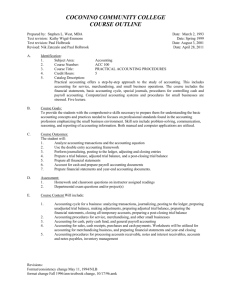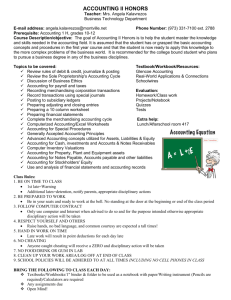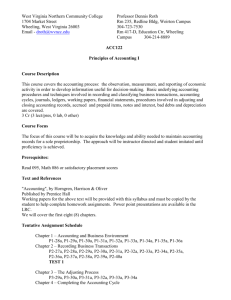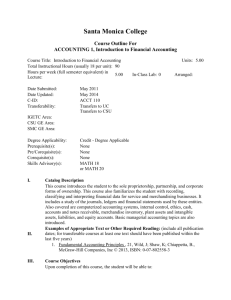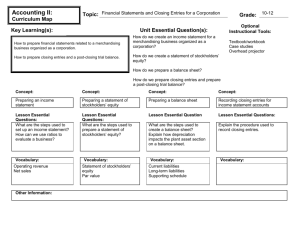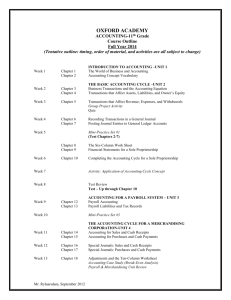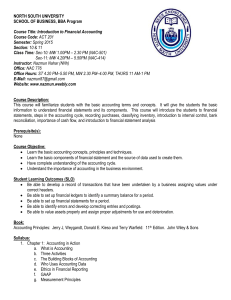Fundamentals of Accounting
advertisement
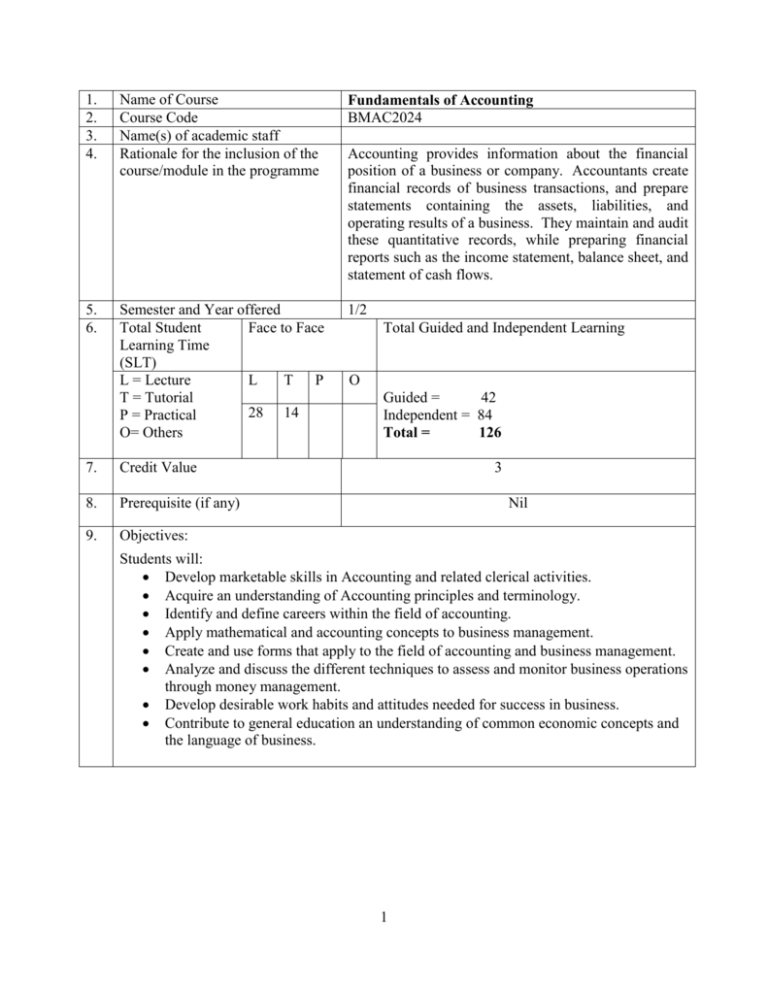
1. 2. 3. 4. Name of Course Course Code Name(s) of academic staff Rationale for the inclusion of the course/module in the programme Fundamentals of Accounting BMAC2024 5. 6. Semester and Year offered Total Student Face to Face Learning Time (SLT) L = Lecture L T P T = Tutorial 28 14 P = Practical O= Others 1/2 7. Credit Value 8. Prerequisite (if any) 9. Objectives: Accounting provides information about the financial position of a business or company. Accountants create financial records of business transactions, and prepare statements containing the assets, liabilities, and operating results of a business. They maintain and audit these quantitative records, while preparing financial reports such as the income statement, balance sheet, and statement of cash flows. Total Guided and Independent Learning O Guided = 42 Independent = 84 Total = 126 3 Nil Students will: Develop marketable skills in Accounting and related clerical activities. Acquire an understanding of Accounting principles and terminology. Identify and define careers within the field of accounting. Apply mathematical and accounting concepts to business management. Create and use forms that apply to the field of accounting and business management. Analyze and discuss the different techniques to assess and monitor business operations through money management. Develop desirable work habits and attitudes needed for success in business. Contribute to general education an understanding of common economic concepts and the language of business. 1 10. Learning outcomes: At the completion of the subject, students should be able to perform the following tasks: Analyze a company’s current liabilities and long-lived assets; Prepare depreciation and amortization journal entries. Understand and calculate money valuation using the time value of money principles. Discuss and account for debt financings and corporate stock transactions, and their valuation. Prepare and analyze a cash flow statement; Identify/apply the tools for evaluating a company’s performance. Create an Excel spreadsheet of selected accounting information, including formatting, calculating, and labelling of financial data. Improve “test for understanding” skills with the instructor, to assure he/she is on track. Make several oral presentations of homework problems to the class. Improve the following skills: learning, written communication, teamwork, deductive reasoning, and critical thinking. 2 11. Transferable Skills: Cognitive: Describe the nature, functions, scope and limitations of accounting, its major users and uses, its relationship to other discipline, and its professional status. Develop basic skills in analyzing, recording, classifying, and summarizing transactions of a single proprietorship engaged in service and merchandising business. Equip oneself with a working knowledge of financial statements, their purposes, and uses. Understand the basic accounting principles, theories, and concepts, as they apply to specific accounts, like cash, receivables, payables, inventories and plant assets. Psychomotor: Apply the basic accounting principles, theories and concepts, as they apply to specific accounts, like cash, receivables, payables, inventories and plant assets. Apply the skills in systematic problem solving. Operate accounting equipment such as calculator and computer as appropriate to the subject matter. Prepare in good form properly classified financial statements for single proprietorship engaged in service and merchandising business. Affective: Appreciate the need for the fair and reliable reporting of assets, liabilities, owner’s equity, revenue, and expenses, as they affect the economic decision of statement users. Appreciate the significance of the accounting to his/her personal life. Appreciate internal control system, business documents and forms, their designs/ uses and relationships with accounting records and reports. Appreciate the logic of double-entry bookkeeping, the nature and significance of each step in the accounting cycle. 12. Teaching-learning and assessment strategy A variety of teaching and learning strategies are used throughout the course, including: Lecture sessions Tutorial sessions Case Studies Student-Lecturer discussion Collaborative and co-operative learning Workshops and Training Seminars Independent study Assessment strategies include the following: Ongoing quizzes Midterm tests Performance Assessment (Participation, project, Assigned exercises) Case Presentations 3 13. Synopsis: This course provides an introduction to accounting, within the context of business and business decisions. Students explore the role of accounting information in the decisionmaking process and learn how to use various types of accounting information found in financial statements and annual reports. This course starts with a discussion of accounting thought and the theoretical background of accounting and the accounting profession. Also discussed are special journals, the voucher system, and simple bank reconciliation. 14. Mode of Delivery: Face to Face Lecture sessions Tutorial sessions 15. Assessment Methods and Types: The assessment for this course will be based on the following: Coursework 50% Quizzes Assignments Project Mid-Semester Exam Final Examination 16. 10% 10% 10% 20% 50%. Total 100% Mapping of the course/module to the Programme Aims The individual course is mapped to the programme aims using a scale of one to five where (one being the least relevant/related and five being the most relevant/ related). 17. A1 A2 A3 A4 A5 A6 2 2 4 2 2 2 Mapping of the course/module to the Programme Learning Outcomes The learning outcomes of this course are mapped to the eight MQF domains using a scale of one to five where (one being the least relevant/related and five being the most relevant/ related). LO2 LO3 LO4 LO5 LO6 LO7 LO8 4 3 4 2 2 3 2 2 LO9 2 LO10 LO11 4 4 LO12 2 Content outline of the course/module and the SLT per topic WEEK Details L 4 T Total SLT Indep. 18. LO1 WEEK 1, 2 Introduction to Accounting Definition, purpose and nature of accounting Users of accounting information: o Internal users o External users Ethical considerations in Accounting and Business Forms of business organization and their activities (e.g., financing, investing and operating) Accounting concepts and principles The financial statements of business organizations Relationships among the financial statements Definition, classification and examples of assets, liabilities, capital or owners’ equity, income, and expenses The accounting profession: career opportunities Specialized accounting fields o Public accounting o Private accounting o Government accounting o Accounting education 4 2 12 18 WEEK 3 Analyzing business transactions The accounting equation. Definition of business transactions and source documents. Transactions affecting only balance sheet accounts. Transactions affecting income statement accounts. Summarizing routine transactions by preparing: Income statement o Capital statement o Balance sheet 2 1 6 9 5 WEEK 4 Recording transactions of a service company The Account and T-account. Rules of debit and credit. Double-entry accounting. Recording in two-column journal o initial investment by owner o changes in assets, liabilities and capital. o changes in income and expenses. o withdrawals of owner. Determining the balances of accounts and their normal balances. Posting to the ledger. Cross-indexing. Making the trial balance 2 1 6 9 WEEK 5, 6 Measuring Business Income: The Adjusting Process Accrual-basis accounting vs. Cash-basis accounting. The accounting period. Revenue principle. Matching principle. The Time-Period concept. Overview of the adjusting entries. Adjustments to the accounts: o Prepayments (Deferrals) o Accruals o Provision for uncollectible accounts receivable o Depreciation of plant asset Preparing the adjusted trial balance. Preparing the financial statements from the adjusted trial balance. 4 2 12 18 6 WEEK 7, 8 Completing the accounting cycle for a service company Overview of the accounting cycle. Preparing an accounting worksheet. Using the worksheet. Preparing financial statements from the worksheet. o Income statement o Capital statement o Classified balance sheet o Cash flow statement (simple cash receipts & disbursements) Journalizing and posting adjusting entries. Journalizing and posting closing entries. Preparing the post closing trial balance Preparing the reversing entries. Use of accounting information in decision-making: Accounting Ratios WEEK 9, 10, 11 Merchandising and the Accounting Cycle Merchandising operations o Business documents o Operating cycle of a merchandising business Recording merchandising business transactions in a two-column general journal o Sales revenue o Sales returns and allowances o Sales discounts o Purchases of merchandise o Purchases returns and allowances o Purchase discounts o Transportation costs o Inventory systems o Perpetual inventory procedure o Periodic inventory procedure Determination of o merchandise inventory o costs of good sold o gross margin Worksheet preparation Adjusting and closing process for a merchandising business Financial statements of a merchandising business Income statement format Use of accounting information in decision making 7 4 2 12 18 6 3 18 27 19. WEEK 12 Recording transactions in special journals Nature and use of control accounts and subsidiary ledgers Types of special journals o sales journal o purchases journal o cash receipts journal o cash disbursements journal Recording of financing, investing and operating transactions in the special journals and general journal WEEK 13, 14 Cash Transactions, Internal Control and Ethical Issues The Bank Account as a Control Device Preparation of simple bank reconciliation statement Internal control measures over cash receipts and disbursements o Use of Imprest Cash System o Accounting for Petty Cash Fund o Voucher System Procedures for preparing a voucher Special journals used Procedures for paying a voucher Files maintained Total Main references supporting the course: 2 1 6 9 4 2 12 18 28 14 84 126 Harrison, Horngren & Thomas. (2010). Financial Accounting, Pearson, (8th Edition) Additional references supporting the course: 1. Scott. (2009). Financial Accounting Theory. Pearson, (5th Edition) 2. Barry Smith. (2010). Introductory Financial Accounting. McGraw-Hill, (1st Edition) 3. Jerry J. Weygandt, Paul D. Kimmel, Donald E. Kieso. (2010). Financial Accounting. Wiley, (7th Edition) 20. Other additional information All related subject materials will be available to the students during the period of the course 8
